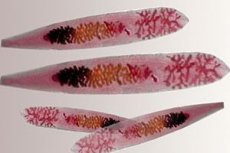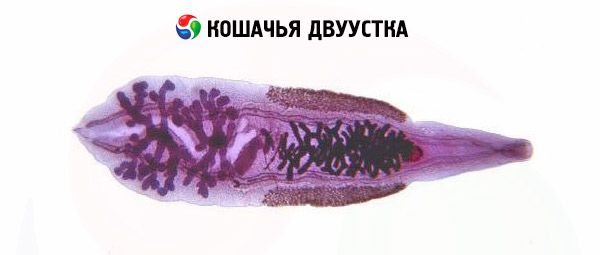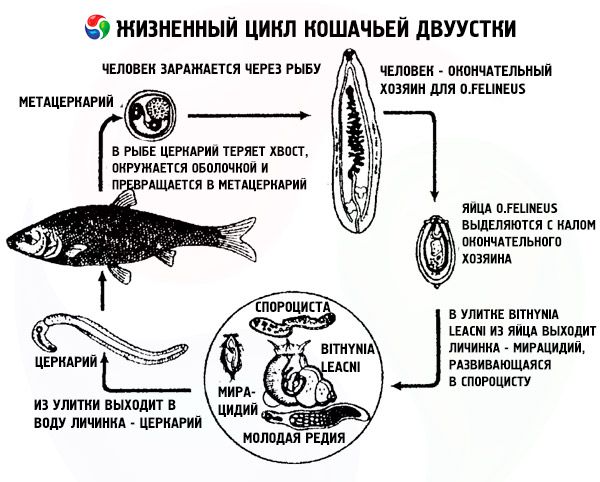Medical expert of the article
New publications
Cat bilharzia
Last reviewed: 06.07.2025

All iLive content is medically reviewed or fact checked to ensure as much factual accuracy as possible.
We have strict sourcing guidelines and only link to reputable media sites, academic research institutions and, whenever possible, medically peer reviewed studies. Note that the numbers in parentheses ([1], [2], etc.) are clickable links to these studies.
If you feel that any of our content is inaccurate, out-of-date, or otherwise questionable, please select it and press Ctrl + Enter.

The cat fluke flatworm belongs to the class Trematoda Digenea (digenetic flukes), subclass Fasciola (fasciola), family Opisthorchis (opisthorchiasis). Some classifications include the species of this parasite in the suborder Heterophyata (heterophytes).
The cat liver fluke (Opistorchis felineus) is sometimes also called the cat liver fluke or Siberian fluke, although the chronic hepatobiliary damage (opisthorchiasis) caused by this helminth is a common infection of fish-eating mammals (including humans) from Eastern Europe to the Asia-Pacific region.
Structure of the cat fluke
The species of opisthorchid fluke that cause opisthorchiasis, in addition to the cat fluke, include Opisthorchis viverrini, common in Southeast Asian countries, and Clonorchis sinensis (Chinese fluke). And among the liver flukes that affect cattle, such flatworms of similar morphology as Fasciola hepatica and Dicrocoelium dendriticum are noted.
The structure of the cat fluke has been studied quite well by parasitologists. The body of the worm is flat, shaped like a narrow leaf: the length rarely exceeds 1.5 cm (on average, 5-10 mm), and the width varies from 0.7 to 1.6 mm.

The cat fluke's body is covered with syncytial epithelium (tegumen), under it is a basal membrane, and under it are smooth muscle fibers. There are two suckers (oral and abdominal); in the oral sucker there is an oral opening leading into the pharynx, equipped with muscles that ensure both the absorption of food and the removal of waste products (since the worm's intestines do not have an opening at the opposite end).
The reproductive system of the cat fluke is hermaphroditic, that is, the worm has a uterus for eggs, an ovary, and testicles. The oval-shaped eggs of the cat fluke are equipped with a lid for the exit of the larva.
Life cycle of cat fluke
The entire life cycle of the cat fluke, according to biologists, lasts four to six months. That is, during this time the worm, changing intermediate hosts, develops from the egg stage to the adult state - marita.
The eggs with miracidia larvae are found in fresh water, where they are swallowed by Bithynia snails - the gastropods Bithynia leachi, which are the first intermediate host of the cat fluke. In the digestive system of the mollusk, the eggs open, releasing miracidia that affect the tissues of the host's internal organs. This is the first larval stage of the parasitic worm's life cycle.
Then comes the second larval stage: the miracidium forms an immobile sporocyst, in which germ cells are formed. During the third larval stage, these cells, through parthenogenetic reproduction, produce mobile larvae - rediae, which feed and reproduce intensively. This leads to the appearance of cercariae, which are the fourth larval stage of the cat fluke. The cercarial larvae emerge from the snails and move freely in the aquatic environment thanks to the tail-like appendage they have, and this stage of the parasite's development is already invasive (infectious), since the cercariae are looking for a host.
The second intermediate host of the fluke is carp fish, into whose body the cercariae penetrate unhindered (through the gill slits and through the outer coverings) and spread throughout the body, primarily in muscle tissue. Here the cercariae continue to grow and pass into the metacercariae stage (Cyprinus carpio). The tail falls off as unnecessary, but after 30-40 days a capsule-type shell appears to protect the metacercariae.
At this stage, the cat fluke is ready to move on to its final host - a predatory mammal or a human. Having entered the gastrointestinal tract along with the eaten infected fish, the helminth metacercariae lose their protective shell (it is dissolved by gastric juice during the digestion process), and the released larvae penetrate into the most suitable place for them - the liver.
Attaching themselves to liver tissue, the metacercariae eventually grow to the adult hermaphrodite stage – ready to lay eggs. It is in this form that the cat fluke parasitizes the liver of the infected person (often for decades), and the eggs it lays end up in sewage drains with feces, and then in water bodies. And the next life cycle of the cat fluke begins.

The ways in which humans become infected with this helminth are by eating fish that has not been heat treated, that is, undercooked or undercooked, dried, salted or cold smoked.
Today, according to WHO, the danger of infection with this parasite really threatens 80 million inhabitants of our planet.
Symptoms of cat fluke, that is, signs of infection with opisthorchiasis, diagnosis of this parasitic disease, treatment of cat fluke (drugs for the treatment of cat fluke and treatment with folk remedies), as well as the prognosis of opisthorchiasis and prevention of infection with cat fluke are discussed in detail in our publication - Opisthorchiasis.


 [
[